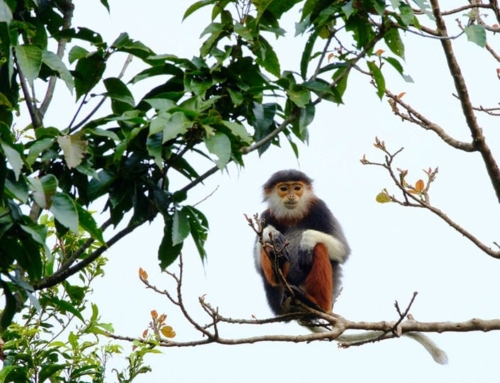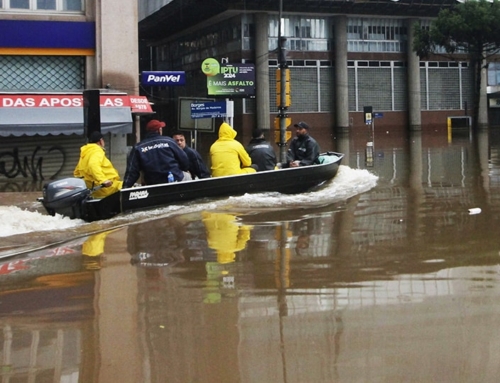2020 is a big year for climate action. It is the start of a decade of climate action. But if we’re talking climate, we need to be talking about conservation and regeneration, argues our CEO Kirsty Schneeberger.
2020 is a big year for climate and a big year for biodiversity.
Five years on from the momentous UN conference that delivered the Paris Agreement, swiftly followed by the fastest entry into force of any international environmental Treaty, it’s time for countries to step up and deliver on climate action. 2019 and 2020 so far have seen some of the worst climate impacts ever with record temperatures and prolonged droughts causing the devastating fires in Australia; back to back storms in the UK causing severe flooding with warnings still in place; and the temperature of Antarctica rising above 20°C for the first time ever.
Similarly we are witnessing a mass extinction of species on an unprecedented scale and pace, an ecological crisis that threatens everything we know about life on earth. In 2019 ‘ecological debt day’ was the 29th July. This day marks the moment when we have used up the year’s available resources and we go into resource overdraft. As we all know, paying off an overdraft is not easy and the longer we leave it the harder it will be to achieve.
A decade of action
The UN climate conference to be held in Glasgow this November will be an important venue for further commitments to action and demonstrations of milestones and achievements already reached. Just as the UN biodiversity talks to be held in China in October will set science-based targets on what we need to do to preserve and conserve nature.
Both will underpin the decade of action and ambition that we are entering into. 2020 – 2030 presents a unique and invaluable window of opportunity to avert disaster and set us on track to achieve both temperature and nature goals.
But we need more than that – whilst governments can set the tone and agree to a framework of action it won’t be nearly enough to rely on alone.
That’s why we need action happening on the ground.

Tree nursery at Tesoro Escondido Reserve, Ecuador. Image: Synchronicity Earth
Two sides of the same coin
We also need to recognise that action on climate and action on biodiversity are actually two sides of the same coin. We know that climate impacts affect nature – be it animals perishing in forest fires, or coral bleaching events that are destroying underwater ecosystems. We also know that loss of biodiversity exacerbates climate change – deforestation and mangrove destruction prevent CO2 from being absorbed by these important ‘carbon sinks’ meaning more CO2 is left in the atmosphere – contributing to as much as 30% of global greenhouse gas emissions. As a consequence of all this, biodiversity loss is also crippling nature’s ability to adapt to changes. Meaning we get stuck in a vicious cycle of one causing the other that in turn causes the other again.
But the crucial question is: can we turn that into a virtuous cycle? If climate and biodiversity are so inextricably linked and impact on each other negatively, surely we can harness their interconnectedness and trigger positive feedback loops that bring about positive change?
Luckily, the answer is yes.

Image: Joel Vodell
The cycle of recovery
The relationship between the land and sea with air is a simple but crucial one. The air is full of gases that keep getting put out there via the burning of fossil fuels. The land and sea can absorb those gases and often keep them locked away for hundreds if not thousands of years. This ‘carbon cycle’ is what keeps a healthy balance of life on earth. But currently this delicate balance isn’t being maintained. We are putting too much gas into the atmosphere and we are destroying nature’s natural ability to absorb it back.
A lot of the attention that climate change gets is around stopping the burning of fossil fuels and preventing the release of greenhouse gases into the atmosphere. Important as that is, now our attention must turn to enhancing the carbon sinks if we are to truly restore balance.
Article 4.1 of the Paris Agreement states ‘…Parties aim to reach global peaking of greenhouse gas emissions as soon as possible, recognizing that peaking will take longer for developing country Parties, and to undertake rapid reductions thereafter in accordance with best available science, so as to achieve a balance between anthropogenic emissions by sources and removals by sinks of greenhouse gases …’
This is, in essence, what people mean when they talk about ‘net zero’; and you can see why biodiversity and nature play such a vital role in our action on climate change.
So far nearly 20 countries have committed to achieving ‘net zero’ by 2050 or sooner. The IPCC ‘Special Report on Climate Change’ outlined a variety of pathways of how net zero can be achieved globally. Now we need to deliver on it.

Image: Hutan
Nature-based solutions
Referred to as ‘nature-based solutions’ (or as Dr Jane Goodall referred to them at the Global Climate Action Summit ‘forgotten solutions’), it has been shown that improving soil productivity, cleaning air and water, and maintaining biodiversity can ‘provide over one-third of the cost-effective mitigation needed between now and 2030 to stabilise warming.’
Achieving this will not be without challenges. Despite the large potential of these solutions, it was estimated from 2015 data that land-based carbon absorbing efforts receive only about 2.5% of climate mitigation dollars; and more recently it was estimated that ten times more investment or up to USD 440 billion per year is needed to achieve the Aichi Biodiversity Targets by 2020. Currently only USD 52 billion goes towards biodiversity funding globally.
That’s where Synchronicity Earth’s work can play a vital role: in closing that funding gap. Since 2012, we have been funding and supporting a range of partners who are already delivering nature-based solutions, globally. Whilst a large proportion of Synchronicity Earth’s work does focus on species conservation, it also supports reforestation, mangrove restoration, and habitat protection – all of which contribute to enhancing nature’s carbon sinks.
Our team has identified where the world’s most important carbon sinks are under threat, and has built partnerships with local groups who are on the front line of restoring them. These areas are overlooked and underfunded, which is why Synchronicity Earth’s support really makes a difference.

Image: ITF
Conservation climate impact on the ground
Below are some highlights of the work of Synchronicity Earth’s partners and the impact that they have already delivered through their nature-based approaches.
The Congo Basin is home to the world’s second largest contiguous tract of rainforest (covering 1.8 million km2). It is a huge sink for the world’s carbon, holding a significant portion of the world’s forest-based carbon. DRC alone holds eight per cent.
- 1 million hectares of forest in the Congo Basin have increased protection because of SE funded work to restore rights to indigenous groups
- 43,411 hectares of land recognised under community law
- Crop diversification with over 5,000 villagers including cultivating 8 different crops
Papua New Guinea (Act Now and Bismarck Ramu Group)
PNG is home to the world’s third largest tract of contiguous rainforest and boasts immense coastal biodiversity.
- Stopped logging on 4.4 million hectares of land
Liberia (Sustainable Development Institute)
Liberia is home to 45% of the remaining Upper Guinean rainforest in West Africa. These forests and their associated biodiversity, as well as the rural communities that depend on them for their livelihoods, are under immense threat from destructive activities such as logging, mining, and large-scale agricultural concessions.
- Stopped corporate cultivation of more than 10,000 hectares of land
South East Asia: Thailand and Myanmar (MAP)
Mangroves are found in the coastal regions of more than 120 countries and represent some of the most biodiverse habitats on the planet, these blue forests also absorb up to 5 times more carbon than terrestrial forests, as well as providing a host of tangible community benefits. Despite this, mangrove deforestation continues apace. They are being cleared at between three and five times the rate at which other forests are being lost. It is estimated that mangroves have declined by as much as 35% since 1980, globally.
- 2 hectares of mangroves restored
- Mangrove restoration supports local economy
Tanzania (ITF)
Tanzania’s forests are being lost at a rate of 130,000 hectares per year, the fifth fastest rate of any country globally.
- 12,200 seedlings planted in year one; 80% success rate
- 33,000 will be planted over 75 hectares of land
- 40% of income from sustainable timber management goes to community development fund
Malaysia (Hutan)
Kinabatangan floodplain, a part of Borneo that has already lost 80 per cent of its natural forest to palm oil plantations.
- 15 hectares of land restored and 25,000 seedlings planted (38 native species) and 80% success rate
- Seedling nursery generates income for local families
- Conserving threatened species of hornbills to aid natural seed dispersal
Ecuador (Jocotoco)
Tesoro Escondido is a wildlife reserve located in the province of Esmereldas, Ecuador.
- Restoring 30 hectares of land; so far 10,000 seedlings planted
These achievements show that action on the ground can make a difference and deliver vital impacts; and can get us back on track to having a healthier balance in the carbon cycle. Climate and biodiversity might be two sides of the same coin, but we don’t want to leave the fate of our planet to a coin toss. So, let’s not take any chances.
Let’s instead invest in those nature-based solutions and use the next 10 years to restore that balance if we are to support the flourishing of all life on earth. One of these solutions is restoring degraded ecosystems, which is the focus of our Regeneration Programme with our partners Mangrove Action Project, HUTAN, International Tree Foundation and Tesoro Escondido.





